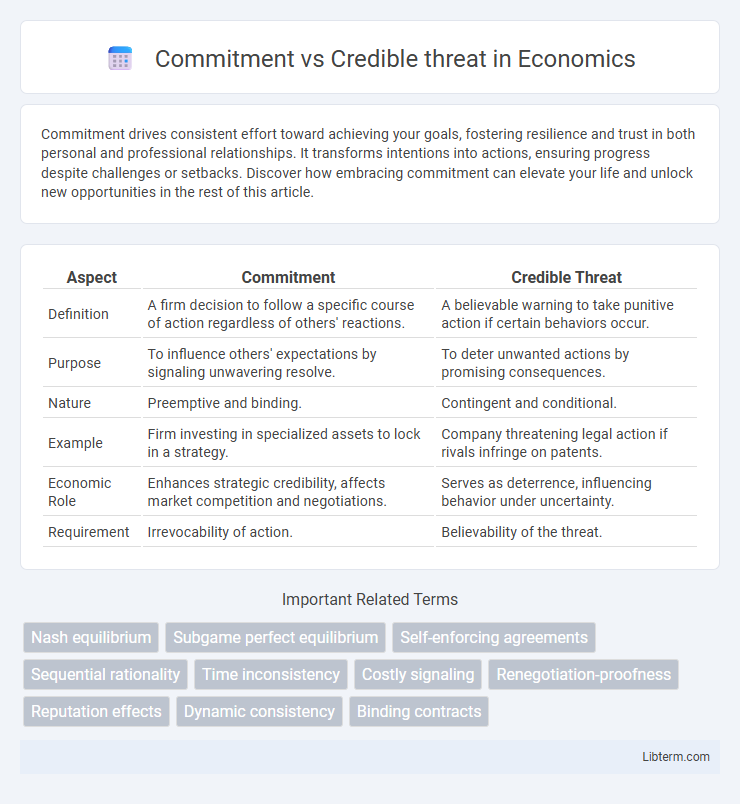Commitment drives consistent effort toward achieving your goals, fostering resilience and trust in both personal and professional relationships. It transforms intentions into actions, ensuring progress despite challenges or setbacks. Discover how embracing commitment can elevate your life and unlock new opportunities in the rest of this article.
Table of Comparison
| Aspect | Commitment | Credible Threat |
|---|---|---|
| Definition | A firm decision to follow a specific course of action regardless of others' reactions. | A believable warning to take punitive action if certain behaviors occur. |
| Purpose | To influence others' expectations by signaling unwavering resolve. | To deter unwanted actions by promising consequences. |
| Nature | Preemptive and binding. | Contingent and conditional. |
| Example | Firm investing in specialized assets to lock in a strategy. | Company threatening legal action if rivals infringe on patents. |
| Economic Role | Enhances strategic credibility, affects market competition and negotiations. | Serves as deterrence, influencing behavior under uncertainty. |
| Requirement | Irrevocability of action. | Believability of the threat. |
Understanding Commitment in Decision-Making
Commitment in decision-making involves a firm and unchangeable stance that influences the expectations and actions of other parties, enhancing strategic credibility. Unlike a credible threat, which must be believable without full obligation, commitment requires binding oneself to a course of action, often through irreversible moves or promises. Understanding this distinction improves negotiation tactics by clarifying when to leverage commitment to shape outcomes versus when to maintain flexibility with credible threats.
Defining Credible Threats in Strategic Interactions
Credible threats in strategic interactions are commitments backed by the capability and willingness to carry out a specified action if certain conditions arise. These threats gain credibility when the threatening party has both the resources and the incentive to follow through, making the threat believable to others. In game theory and international relations, credible threats influence opponents' decisions by altering their expectations about potential consequences.
Key Differences: Commitment vs. Credible Threat
Commitment involves a binding promise to follow a specific course of action, enhancing trust and predictability in strategic interactions, while a credible threat depends on the perceived ability and willingness to carry out a punitive action if demands are not met. Commitment typically requires mechanisms to make reneging costly or impossible, ensuring the promise is believable, whereas a credible threat hinges on rational calculation of consequences and the threatener's incentives. The key difference lies in commitment's proactive assurance versus credible threat's reactive intimidation, both shaping opponents' expectations and strategic decisions.
Psychological Foundations Behind Commitment
Commitment stems from the psychological need for consistency and trustworthiness, where individuals or entities signal firm intentions to influence others' behavior. Credible threats rely on perceived capability and willingness to follow through, requiring a balance between assertiveness and believability to avoid undermining authority. Understanding cognitive biases and emotional responses helps clarify why commitment often results in stronger, more stable outcomes than fleeting threats.
Elements That Make a Threat Credible
A credible threat requires the threatener to have both the capability and the resolve to carry out the threat if demands are not met. Elements such as clear communication, a history of consistent follow-through, and the perceived costs and benefits reinforcing the threat's seriousness bolster credibility. The alignment of incentives and the absence of incentives to bluff ensure the threat is taken seriously in strategic interactions.
Real-World Examples of Commitment Strategies
Governments often use credible commitment strategies in trade negotiations by setting binding tariff schedules to signal resolve and deter counteractions. In conflict resolution, the U.S. deployed credible commitment through troop deployments in South Korea to assure allies and deter aggression from North Korea. Corporate firms, such as Apple, commit to long-term contracts with suppliers to secure resources and gain competitive advantage, illustrating practical application of commitment strategies in business environments.
Case Studies: Effective Use of Credible Threats
Case studies demonstrate that credible threats effectively influence international negotiations and conflict resolution by showcasing clear, believable consequences for adversaries. For example, during the Cuban Missile Crisis, the United States' credible threat of military action compelled the Soviet Union to withdraw missiles, avoiding nuclear confrontation. In business, companies employing credible threats in competitive strategies, such as potential price wars, secure better market positions by signaling a willingness to bear short-term costs for long-term gains.
Commitment Failures and Their Consequences
Commitment failures arise when parties cannot credibly assure their intentions, leading to missed agreements in negotiations or conflicts. These failures often escalate tensions, resulting in costly conflicts or prolonged stalemates due to lack of trust. Understanding the dynamics of credible threats and reliable commitments is crucial for preventing breakdowns in cooperation and fostering stable relationships.
Enhancing Negotiation with Credible Threats
Enhancing negotiation with credible threats requires demonstrating clear, consistent consequences to influence the opposing party's decision-making effectively. Using well-defined, believable stakes increases leverage by signaling genuine commitment without resorting to empty posturing. Establishing trust in the threat's authenticity facilitates outcome predictability and strengthens the negotiating position.
Choosing Between Commitment and Credible Threat in Strategy
Choosing between commitment and credible threat in strategy hinges on the credibility and enforceability of the threat or promise made to competitors or stakeholders. A credible threat requires a commitment that is both believable and costly to reverse, ensuring opponents perceive the risk of non-compliance as genuine. Strategic decision-makers assess the balance between flexibility and rigidity, opting for commitment when it solidifies market position or credible threat when deterrence effectively influences competitor behavior.
Commitment Infographic

 libterm.com
libterm.com